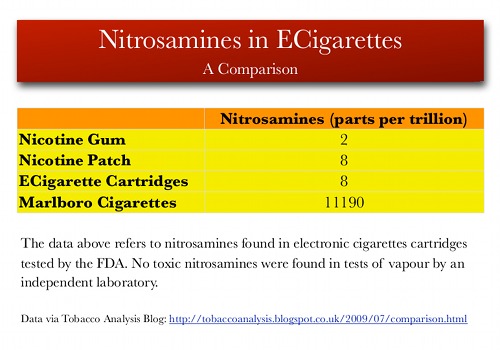 |
| The researchers used a second-generation e-cig that probably looks like this. |
It's great to see the Greeks are winning the battle in electronic cigarette research. Doctor Farsalinos and his formidable team are once again kicking pro-tobacco propagandists' butts with their latest findings.
Here's how they did it...
First, the team selected three brands of e-juices from the market. They prepared testing samples in their liquid and aerosol forms and checked them for levels of tobacco-specific nitrosamines (TSNAs).
Three 100-puff sets from each liquid were trapped in filter pads and were subsequently analyzed for the presence of TSNAs. The expected levels of TSNAs (calculated based on the liquid consumption) were compared with the measured levels in the aerosol.Next, the researchers prepared a control sample of flavored e-juice and deliberately added a cocktail solution of known nitrosamines to it.
Farsalinos and his team measured the levels of N-nitrosonornicotine (NNN), N-nitrosoanatabine (NAT), N-nitrosoanabasine (NAB), and 4-(methylnitrosamino)1-(3-pyridyl)-1-butanone (NNK) (if found) in each e-juice, including the spiked sample. Thousands of carcinogens are found in tobacco smoke, but these four were likely chosen because they have clearly identifiable markers that make them particularly easy to find and measure.
 |
| Here's a quick rundown of the levels of nitrosamines found by the FDA in nicotine gum, nicotine patch, e-cigarette liquids, and analog cigarettes. Image via The Ashtray Blog. |
And, this is what the researchers found out...
Only NAB was found at trace levels in two commercial liquids (1.2 and 2.3 ng/g), while the third contained 1.5 ng/g NAB and 7.7 ng/g NNN. The 100-puff sets resulted in 336–515 mg liquid consumption, with no TSNAs being detected in the aerosol.Tests done on the three e-liquid samples revealed that they're not completely free from the taint of TSNAs. The nicotine juice was likely contaminated during the extraction process. The researchers acknowledge that these "trace amounts" don't present an immediate danger to vapers and the people around them.
Here's the reason why the TSNAs were totally absent in aerosol samples:
Due to the very low levels of TSNAs in the commercial liquids, the respective aerosol samples contained, as expected, no TSNAs above the LOD [limit of detection].
When someone vapes e-juice that's been tainted with TSNAs, what happens to the nitrosamines? Well, they'll likely be absorbed into the bloodstream and end up in your lungs, brain, liver and kidneys. These carcinogenic compounds remain in your body for a little while before they're expelled through the excretory system.
 |
| Trace Amounts of Nitrosamines Found in Electronic Cigarette Liquids |
Read The Research Team's Concluding Statements
In their conclusion, the researchers stated that "exposure of EC users to TSNAs can be accurately assessed based on the levels present in the liquid, without the need to analyze the aerosol." The following text from the research paper of Farsalinos, et al expounds on this statement:
The levels of TSNAs in the EC liquids are minimal and by far lower compared to tobacco. This is probably attributed to the use of pharmaceutical grade nicotine that most manufacturers claim to use. This grade of nicotine is highly purified to remove the majority of impurities, including TSNAs.
However, there were no published reports evaluating if additional TSNAs can be formed during EC aerosol production. This is important since ECs are used in aerosol and not in liquid form, and heating is involved in the evaporation process.
The study herein verifies that the levels present in the aerosol are similar to those present in the liquid. Therefore, the analysis of TSNAs levels in the liquid would be enough to estimate the exposure of consumers to these substances, without the need to perform more complex and expensive analyses in the aerosol.
No comments:
Post a Comment